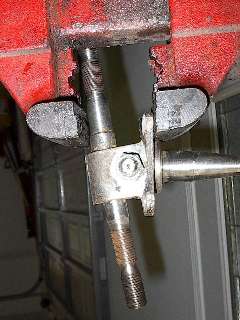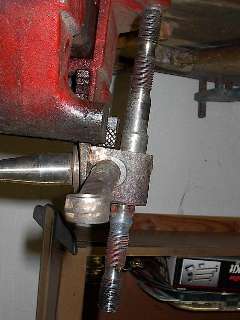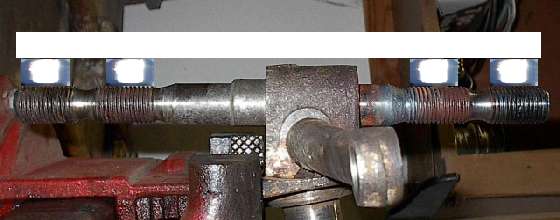The MGA With An Attitude
Straightening a BENT SWIVEL PIN -- FS-204
At 08:15 PM 1/19/05 -0700, Ken Bowen wrote:
>"My swivel pin appears to be bent where it enters into the lower trunnion. I had noticed it contorting before the disassembly when rotating the steering arm. Could this have been caused by road hazards?"
Yup. If someone misjudges a turn on slick pavement and slides into a curb at an angle with the steering turned away from the curb and the tire parallel to the curb, it can hit hard and bend the swivel pin. That will almost always destroy the wheel in the process. Then it is common to have no spare wheel, or a replacement wheel that doesn't match the others.

The force on the wheel would have been inward at the bottom at an angle to direction of travel, but mostly hard from the side of the wheel almost directly in line under the axis of the knuckle. That cocks the wheel in at the bottom putting high moment load on the hub and bearing spindle. The knuckle is stronger than the swivel pin, so the swivel pin bends between the bottom swivel link and the knuckle. The bottom extension of the swivel pin will be bowed inward, bent between the thread and the knuckle, with most of the deformation being in the short necked down area just above the thread. See photo at right (click for larger image). The picture (and the vice) is inverted so the swivel pin is right side up. Hold a straight edge up to the picture, and you can see the swivel pin is obviously not straight. This is the right side swivel pin and knuckle seen from the back.

>"Is it possible to bend the swivel pin back?"
Yeah, sort of. I did it once in a pinch for a friend's car. Remove the swivel pin and knuckle from the car. Clamp the thing in a BIG bench vice with the bent end upward, determining in advance which way it's bent so you know which way you have to bend it back to get it straight. Heat with acetylene torch until it is glowing bright red in the vicinity of the bend (being careful not to overheat and distort the crest of the thread). Tap the end sideways gently with a two pound hammer or use a pipe for a lever to make it straight again. Allow to cool slowly, do NOT quench with water (as the thermal stress could cause cracking). There have been some reports of cracks in the swivel pins, even if they have never been bent. It would be a good idea to have them magnafluxed, especially if you do straighten one and want to use it. The second photo (click for larger image) shows the pin after straightening, oriented right side up and seen from the front. Notice the blue tint torch mark just below the knuckle.
When I straightened one in this manner I had to repeat the heat and tweak process two or three times before I got it straight enough to not notice the bend in assembly. You need to mount the swivel pin with the links attached loosely to the suspension arms, and turn the swivel pin full lock left to right without any noticeable motion of the swivel links in the arms. Especially the lower link has to remain stationary in the lower a-arm as the swivel pin rotates.

To gauge the straightness on the work bench, hold the part with the swivel pin horizontal and the spindle hanging downward. Place four identical large hex nuts on the four separate sections of the thread (or use two pieces of thick rectangular key stock). The nuts have to be thick enough to extend higher than the short side of the knuckle. Lay a straight edge across the hex nuts and look for any space between the straight edge and the nuts. With a light behind you may be able to see this within 0.001 inch (0.0025 mm), which is easily close enough for practical use.
Thanks to Ken Bowen for the pictures, before and after his straightening job.
|